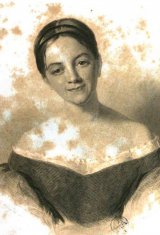The Giant's Causeway
Letitia Elizabeth Landon 1802 (Chelsea) – 1838 (Cape Coast)
They met beside the stormy sea, those giant kings of old,
And on each awful brow was set, a crown of burning gold.
No ray the yet unrisen stars, or the wan moonbeams, gave,
But far and bright, the meteor light shone over cloud and wave.
"I have been over earth to-day," exclaimed one mighty king,
"The toil of half the human race, it is a foolish thing;
For I have seen on Egypt's land, an abject million slave,
To build a lofty pyramid above their monarch's grave.
"Now let us put their works to scorn, and in a single night
Rear what would take them centuries, and nations' banded might,"
Then up arose each giant king, and took a mighty stone,
They laid the quay; they piled the rocks—ere morn the work was done.
Vain fable this ! yet not so vain as it may seem to be,
Methinks that now too much we live to cold reality;
The selfish and the trading world clips man so closely round,
No bold or fair imaginings within our hearts are found.
So vortex-like doth wealth now draw, all other feelings in,
Too much we calculate, and wealth, becomes almost a sin;
We look upon the lovely earth, and think what it may yield ;
We only ask for crops, not flowers, from every summer field.
The mind grows coarse, the soul confined, while thus from day to day
We let the merely common-place eat phantasie away :
Aye, better to believe, I trow, the legends framed of old—
Aught—anything to snatch one thought, from selfishness and gold.
The magnificent basaltic formation on the northern coast of Ireland, called the " Giants' Causeway," presents so artificial an appearance, that some writers hare asserted that it is not a natural production, and it is traditionally said to have been the work of those mighty men of old, after whom it is named. Sir Joshua Reynolds, in his discourses, observes, that " Travellers into the East tell us, that when the ignorant inhabitants of these countries are interrogated concerning the ruins of stately edifices yet remaining among them, the melancholy monuments of their former grandeur and long-lost science, they always answer, that they were built by magicians. The untaught mind finds a vast gulf between its own powers and those works of complicated art which it is utterly unable to fathom, and it supposes that such a void can only be passed by supernatural means. "
Font size:
Submitted by Madeleine Quinn on July 12, 2016
Modified on March 05, 2023
- 2:02 min read
- 144 Views
Quick analysis:
| Scheme | AABB CCBB DDXX EEFF GGHH IIAA X |
|---|---|
| Characters | 2,285 |
| Words | 412 |
| Stanzas | 7 |
| Stanza Lengths | 4, 4, 4, 4, 4, 4, 1 |
Translation
Find a translation for this poem in other languages:
Select another language:
- - Select -
- 简体中文 (Chinese - Simplified)
- 繁體中文 (Chinese - Traditional)
- Español (Spanish)
- Esperanto (Esperanto)
- 日本語 (Japanese)
- Português (Portuguese)
- Deutsch (German)
- العربية (Arabic)
- Français (French)
- Русский (Russian)
- ಕನ್ನಡ (Kannada)
- 한국어 (Korean)
- עברית (Hebrew)
- Gaeilge (Irish)
- Українська (Ukrainian)
- اردو (Urdu)
- Magyar (Hungarian)
- मानक हिन्दी (Hindi)
- Indonesia (Indonesian)
- Italiano (Italian)
- தமிழ் (Tamil)
- Türkçe (Turkish)
- తెలుగు (Telugu)
- ภาษาไทย (Thai)
- Tiếng Việt (Vietnamese)
- Čeština (Czech)
- Polski (Polish)
- Bahasa Indonesia (Indonesian)
- Românește (Romanian)
- Nederlands (Dutch)
- Ελληνικά (Greek)
- Latinum (Latin)
- Svenska (Swedish)
- Dansk (Danish)
- Suomi (Finnish)
- فارسی (Persian)
- ייִדיש (Yiddish)
- հայերեն (Armenian)
- Norsk (Norwegian)
- English (English)
Citation
Use the citation below to add this poem to your bibliography:
Style:MLAChicagoAPA
"The Giant's Causeway" Poetry.com. STANDS4 LLC, 2024. Web. 19 Apr. 2024. <https://www.poetry.com/poem/44979/the-giant's-causeway>.



Discuss the poem The Giant's Causeway with the community...
Report Comment
We're doing our best to make sure our content is useful, accurate and safe.
If by any chance you spot an inappropriate comment while navigating through our website please use this form to let us know, and we'll take care of it shortly.
Attachment
You need to be logged in to favorite.
Log In